#Learn Yoga in India
Explore tagged Tumblr posts
Text
Why India Is the Best Destination for Yoga Teacher Training
India is the best destination for yoga teacher training. India's unique blend of rich spiritual heritage and modern training techniques creates an exceptional environment for aspiring yoga teachers. Immerse yourself in ancient practices amid breathtaking landscapes with affordable and varied programs led by experienced instructors.
#Best Yoga Destination#yoga teacher training in India#Best Destination for Yoga Teacher Training#Authentic Yoga Taining in India#best place to learn yoga#Learn Yoga in India#Best Yoga Teacher Training Destination#Best Location for Yoga Training
0 notes
Text
Support Education in Rural India 🙏
Change a Life Today: isha.co/give24
#sadhguru#consciousness#wisdom#spirituality#motivation#meditation#yoga#education#learning#students#career#india#guru#school
2 notes
·
View notes
Text
Join 100hours Ashtanga Yoga Teacher Training in Goa, India with Oorjayii Yoga!
A 100-hour Ashtanga Yoga Teacher Training (AYTT) is a comprehensive program designed to provide participants with a strong foundation in the practice and teaching of the Ashtanga Yoga Primary Series.
Overview of Ashtanga Yoga Introduction to Ashtanga Yoga, its history, and lineage Understanding the philosophy and principles of Ashtanga Yoga Exploring the Eight Limbs of Yoga as outlined by Patanjali
Asana Practice In-depth study and practice of the Primary Series of Ashtanga Yoga Proper alignment, technique, and modifications for each asana Sequencing and structure of the Ashtanga Yoga series
Breath and Movement Synchronization Introduction to Vinyasa, the linking of breath and movement Understanding the importance of breath in Ashtanga Yoga Exploring the concept of Bandhas (energy locks) and their application
Ashtanga Yoga Philosophy Exploring the philosophical foundations of Ashtanga Yoga Study of key yogic texts such as the Yoga Sutras of Patanjali
Anatomy and Physiology Understanding the concepts of self-discipline, self-study, and surrender Anatomy and Physiology Basic anatomy and physiology relevant to Ashtanga Yoga Understanding the movement and mechanics of the body in the asanas Injury prevention and modifications for different body types
Adjustments and Assists Techniques for safe and effective adjustments and assists in Ashtanga Yoga Developing sensitivity and awareness in providing hands-on assistance Ethical considerations and boundaries in physical touch
Teaching Methodology Principles of effective teaching in Ashtanga Yoga Developing clear and concise verbal cues and instructions Sequencing and structuring a class in the Ashtanga tradition
Pranayama and Meditation Introduction to pranayama (breathing techniques) and its role in Ashtanga Yoga Yoga Ethics and Lifestyle Techniques for developing a steady breath and cultivating prana (life force) Introduction to meditation and its integration into the practice and teaching
Practicum and Teaching Practice Opportunities for supervised teaching practice Providing and receiving feedback on teaching skills Developing confidence and presence as a yoga teacher
Yoga Ethics and Lifestyle Understanding the ethical guidelines and principles of being a yoga teacher Exploring the concept of Ahimsa (non-violence) and its application in daily life Incorporating yogic principles into personal and professional life
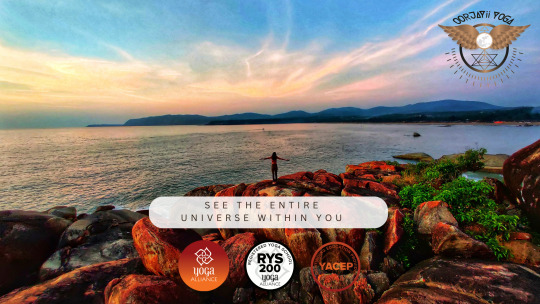
#yogatraining#yogastudent#meditation#yogaretreat#yoga#yogateachertraining#love#vinyasa#healthylifestyle#nature#goa#india#history#culture#sea#beach#today i learned#health & fitness#mental helath#helathyfood
7 notes
·
View notes
Text




AYURVEDA Remedies for COLD, COUGH & ASTHMA
🔸INGREDIENTS
5 gms: Coriander Seeds Powder
5 gms: Rock Sugar Powder
50 gms: Broken Rice
200 ml: Water
🔸Preparation
“Mix all ingredients together in 200ml water.
Take 10-15 ml of the above solution mix 1-tbs of coriander seeds powder, 1-tbs of rock sugar powder & drink 2-3 times in a day.”
🔸Benefits
The Above solution is the best Anti-inflammtory.
The solution is Anti-Spasmodic.
It is the best Bronchodilator, which helps in proper breathing and opens the lungs spasm.
Anyone can take the solution, best for the children and old age people.
.
Follow @ishavasyamyogaschool for more amazing and interesting posts daily 👈🏻
.
Contact us now 👇🏻
https://ishavasyamyogaschool.com/
Email: [email protected]
WhatsApp: +91-9548060842
#ishavasyamyogaschool#yoga#india#yogalife#rishikesh#inspiration#insta#fitness#yogainspiration#yogapractice#knowledge#inspiring quotes#quotes#yoga meditation fitness yogapractice yogainspiration yogalife love yogateacher yogalove yogi yogaeverydamnday mindfulness gym#prosperity#yogirt#my post#positive thoughts#positivity#learning
0 notes
Text
Discover the transformative power of yoga and meditation in our new course
In today's fast-paced world filled with constant stress and anxiety, it is vital to find ways to achieve inner peace and balance in our lives. Yoga and meditation have emerged as powerful tools to help individuals cope with the challenges of modern life and rediscover their true selves. PrakashYoga, a renowned institution known for its holistic approach to yoga and meditation, is excited to offer a new course that promises to transform lives through the practice of these ancient disciplines.
There are several alternatives to fit your unique requirements and goals, whether you prefer the ease of online learning or the immersion experience of studying in India. You may experience yoga's transformational power and set off on a path of self-discovery, healing, and development by making an investment in your yoga education and making a regular practice.
One of the unique features of our course in yoga and meditation is the flexibility it offers. As a distance yoga course learning program, you have the freedom to study at your own pace and convenience, without having to disrupt your daily routine. Whether you are a busy professional, a stay-at-home parent, or a student looking to enhance your well-being, our Lonavala yoga course is designed to accommodate your needs and schedule.
Our training covers a wide range of subjects, including the philosophy and background of meditation as well as the foundations of yoga poses and breathing exercises. In addition to strengthening your attention and concentration, you'll discover how to cultivate mindfulness and forge closer ties with both the outside world and yourself. Our knowledgeable teachers will walk you through every step of the process and provide you the information and resources you need to make positive changes in your life.
PrakashYoga, a haven of calm and tranquility where people may lose themselves in the practice of yoga and meditation, is situated in the peaceful environs of Lonavala. Our course is available online, but even so, you will experience the spirit of our retreat center as you study under our knowledgeable instructors and make connections with a global network of people who are passionate about personal development and self-discovery.
As you progress through the course, you will notice the transformative power of yoga and meditation unfolding within you. You will feel a sense of calm and serenity washing over you, relieving you of the burdens of stress and anxiety that have been weighing you down. Your body will become stronger and more flexible, your mind clearer and more focused, and your spirit elevated to a higher state of consciousness.
You will discover your true potential and draw from your boundless creative and energetic stores by practicing yoga and meditation. You'll experience a renewed feeling of clarity and purpose that will help you make life-improving decisions and realize your dreams.
At PrakashYoga, we are committed to helping you on your journey towards self-realization and personal transformation. Our yoga and meditation course is a doorway to a new way of living and being in the world, not merely a set of instructions. Come along with us on this incredible journey and learn yoga course that will change your life, and discover the countless opportunities that lie ahead of you.
In conclusion, the transformative power of yoga and meditation is unparalleled in its ability to heal the body, mind, and spirit. With PrakashYoga's distance learning course, you have the opportunity to embark on a journey of self-discovery and personal growth that will change your life forever. Seize the chance to reach your full potential and become the finest version of yourself.
#learn yoga course#lonavala yoga course#complete yoga course#residential yoga courses#yoga courses in india
0 notes
Text
https://www.launchora.com/story/how-a-personal-training-course-can-boost-your-care
#online yoga training course in chandigarh#certified personal trainer course#ace certified personal trainer#ace certification gym in india#Best Personal Training Course in India#fitness courses in india#Fitness course in india#ace nutrition course#fitness course in india#best fitness certification course in india#best personal trainer certification in india#fitness coach training in india#ace certification#best fitness course in india#fitness training course in india#Learning of bhangra fitness steps#ace certification personal trainer#personal trainer course in india#trainer certification#certified personal trainer#best fitness trainer in india#fitness nutrition course#fitness certificate coach training in india#best online nutrition courses in india#best nutrition courses in india#online nutrition certification courses in india#best nutrition course in india#online fitness training
0 notes
Text
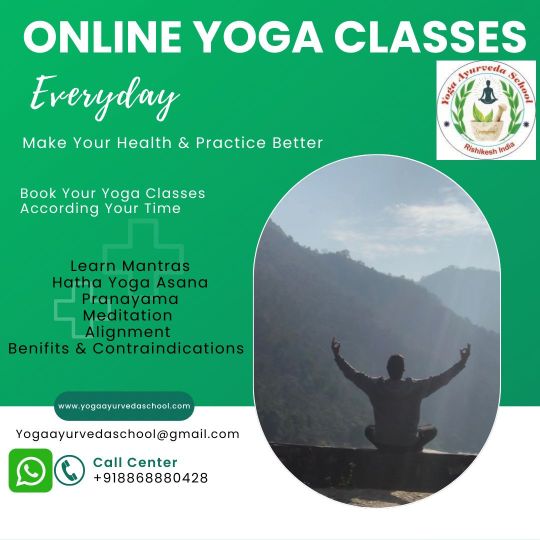
Yoga Ayurveda school offers best online Yoga classes for Everyone private &group classes are available
Private online classes are available
Hatha Yoga
Vinyasa Yoga
Pranayama
Meditation
Yoga Theory
Basic Ayurveda
Alignment
Benifit & contraindications of asana
Anatomy & physiology of asana
Mantras & music 🎶
Contact us for more information
+918868880428
www.yogaayurvedaschool.com
https://www.yogaayurvedaschool.com
#yoga ayurveda school#best online yoga classes#online yoga classes#yoga course in rishikesh#online Ayurveda course#yogaayurvedaschool#yogiclifestyle#best yoga retreat in rishikesh india#best yoga ayurveda retreat in india#yogicinspiration#join us for traditional yoga course learning yogic life style#yogini#yogaretreat#masterhemumasant#medicalyogi#yogicscience#traditional school of yoga ayurveda in india#traditionalschoolofyoga
0 notes
Text
South Asian and Hindu Influences in ATLA (Part 2)
disclaimer: i was raised culturally and religiously hindu, and though i've tried to do my research for this post and pair it with my own cultural knowledge, i'm not an expert on hinduism by any means. should i mess up, please let me know.
please also be aware that many of the concepts discussed in this post overlap heavily with religions such as buddhism and jainism, which might have different interpretations and representations. as i'm not from those religions or cultures, i don't want to speak on them, but if anyone with that knowledge wishes to add on, please feel free.
Part 1
In the previous post, I discussed some of the things ATLA got right in its depictions of desi and hindu cultures. unfortunately, they also got plenty of things wrong - often in ways that leaned towards racist caricatures - so let's break them down, starting with...
Guru Pathik
both the word "guru" and name "pathik" come from sanskrit. pathik means "traveler" or "he who knows the way" while guru is a term for a guide or mentor, similar to a teacher.
gurus were responsible for the very first education systems in ancient india, setting up institutions called gurukuls. students, referred to as disciples, would often spend years living with and learning from their gurus in these gurukuls, studying vedic and buddhist texts, philosophy, music and even martial arts.
however, their learning was not limited merely to academic study, as gurus were also responsible for guiding the spiritual evolution of their disciples. it was common for disciples to meditate, practice yoga, fast for days or weeks, and complete mundane household chores every day in order to instill them with self-discipline and help them achieve enlightenment and spiritual awareness. the relationship between a guru and his disciple was considered a sacred, holy bond, far exceeding that of a mere teacher and student.
aang's training with guru pathik mirrors some of these elements. similar to real gurus, pathik takes on the role of aang's spiritual mentor. he guides aang in unblocking his chakras and mastering the avatar state through meditation, fasting, and self-reflection - all of which are practices that would have likely been encouraged in disciples by their gurus.
pathik's design also takes inspiration from sadhus, holy men who renounced their worldly ties to follow a path of spiritual discipline. the guru's simple, nondescript clothing and hair are reflective of the ascetic lifestyle sadhus are expected to lead, giving up material belongings and desires in order to achieve spiritual enlightenment and, ultimately, liberation from the reincarnation cycle.
unfortunately, this is where the respectful references end because everything else about guru pathik was insensitive at best and stereotypical at worst.
it is extremely distasteful that the guru speaks with an overexaggerated indian accent, even though the iranian-indian actor who plays him has a naturally british accent. why not just hire an actual indian voice actor if the intention was to make pathik sound authentic? besides, i doubt authenticity was the sole intention, given that the purposeful distortion of indian accents was a common racist trope played for comedy in early 2000s children's media (see: phineas and ferb, diary of a wimpy kid, jessie... the list goes on).
furthermore, while pathik is presented a wise and respected figure within this episode, his next (and last) appearance in the show is entirely the opposite.

in the episode nightmares and daydreams, pathik appears in aang's nightmare with six hands, holding what appears to be a veena (a classical indian music instrument). this references the iconography of the hindu deity Saraswati, the goddess of wisdom and knowledge. the embodiment of divine enlightenment, learning, insight and truth, Saraswati is a member of the Tridevi (the female version of the Trimurti), one of the most respected and revered goddesses in the Hindu pantheon... and her likeness is used for a cheap laugh on a character who's already treated as a caricature.
that's bad enough on its own, but when you consider that guru pathik is the only explicitly south asian coded character in the entire show, it's downright insulting. for a show that took so many of its foundational concepts from south asia and hinduism and yet provided almost no desi representation in return, this is just rubbing salt in the wound.
Chakras
"chakra", meaning "circle" or "wheel of life" in sanskrit, refers to sources of energy found in the human body. chakra points are aligned along the spine, with energy flowing from the lowest to the highest point. the energy pooled at the lowest chakra is called kundalini, and the aim is to release this energy to the highest chakra in order to achieve spiritual enlightenment and consciousness.
the number of chakras varies in different religions, with buddhism referencing five chakras while hinduism has seven. atla draws from the latter influence, so let's take a look at the seven chakras:
Muladhara (the Root Chakra). located at the base of the spine, this chakra deals with our basest instincts and is linked to the element of earth.
Swadhisthana (the Sacral Chakra). located just below the navel, this chakra deals with emotional intensity and pleasure and is linked to the element of water.
Manipura (the Solar Plexus Chakra). located in the stomach, this chakra deals with willpower and self-acceptance and is linked to the element of fire.
Anahata (the Heart Chakra). located in the heart, this chakra deals with love, compassion and forgiveness and is linked to the element of air. in the show, this chakra is blocked by aang's grief over the loss of the air nomads, which is a nice elemental allusion.
Vishudda (the Throat Chakra). located at the base of the throat, this chakra deals with communication and honesty and is linked to the fifth classical element of space. the show calls this the Sound Chakra, though i'm unsure where they got that from.
Ajna (the Third Eye Chakra). located in the centre of the forehead, this chakra deals with spirituality and insight and is also linked to the element of space. the show calls it the Light Chakra, which is fairly close.
Sahasrara (the Crown Chakra). located at the very top of the head, this chakra deals with pure cosmic consciousness and is also linked to the element of space. it makes perfect sense that this would be the final chakra aang has to unblock in order to connect with the avatar spirit, since the crown chakra is meant to be the point of communion with one's deepest, truest self.
the show follows these associations and descriptions almost verbatim, and does a good job linking the individual chakras to their associated struggles in aang's arc.
Cosmic Energy
the idea of chakras is associated with the concept of shakti, which refers to the life-giving energy that flows throughout the universe and within every individual.
the idea of shakti is a fundamentally unifying one, stating that all living beings are connected to one another and the universe through the cosmic energy that flows through us all. this philosophy is referenced both in the swamp episode and in guru pathik telling aang that the greatest illusion in the world is that of separation - after all, how can there be any real separation when every life is sustained by the same force?
this is also why aang needing to let go of katara did not, as he mistakenly assumed, mean he had to stop loving her. rather, the point of shedding earthly attachment is to allow one to become more attuned to shakti, both within oneself and others. ironically, in letting go of katara and allowing himself to commune with the divine energy of the universe instead, aang would have been more connected to her - not less.
The Avatar State
according to hinduism, there are five classical elements known as pancha bhuta that form the foundations of all creation: air, water, earth, fire, and space/atmosphere.
obviously, atla borrows this concept in making a world entirely based on the four classical elements. but looking at how the avatar spirit is portrayed as a giant version of aang suspended in mid-air, far above the earth, it's possible that this could reference the fifth liminal element of space as well.
admittedly this might be a bit of a reach, but personally i find it a neat piece of worldbuilding that could further explain the power of the avatar. compared to anyone else who might be able to master only one element, mastering all five means having control of every building block of the world. this would allow the avatar to be far more attuned to the spiritual energy within the universe - and themselves - as a result, setting in motion the endless cycle of death and rebirth that would connect their soul even across lifetimes.
#atla#atla cultural influences#hinduism in atla#welp i thought this would be the last part but i ended up having more to talk about than i thought#so i'll save the book 3 inspirations for the next post#including my absolute favourite combustion man#and by favourite i mean kill it with fire why did you ever think this was okay to do writers
530 notes
·
View notes
Text
Dick Grayson x South Asian!Reader HCs
requested | reader is fem; like with Jason's hc post, I tried to keep it non-specific to any country, hope i achieved that😬
also it's barely mentioned but as a special treat: reader is trained in Indian classical dance😏😏😏
batboys x south asian!reader masterlist
He loves watching Bollywood movies, but gets especially into the music…like really into it
This man becomes OBSESSED with Shreya Goshal; you come early one night to find him singing along to both parts of the duet Manwa Laage from Happy New Year while doing the dishes (which, if you don't know, is a very high-pitched song). He's so off-key but so into it you don't have the heart to tell him that your neighbors texted you to ask if a feral cat got loose in your apartment💀
Then it escalates— he tries to learn Hrithik Roshan’s dance from Dhoom Again (which has nothing to do with the fact that you told him Hrithik Roshan was your childhood crush)
(if ur not desi, it starts at timestamp 0:38 I highly recommend watching it for full context it's incredible— if you are then I know you already know what i'm talking about LMAOO)
And since you're a dancer you learn it with him but he’s genuinely upset that it’s so easy for you but so hard for him
"I should be getting this! Do you know how bendy my body is?!"
For some reason I feel like he would love the strong female lead-type movies (probably because he’s so eldest daughter coded) so movies like Queen, Dangal, Chak De India, that’s his jam, but he loves Kal Ho Naa Ho when he needs a good cry
If you’ve ever seen those tiktoks of families who dress up their dogs and cats in traditional wear…you’re doing that with Haley 100%
I think Dick is familiar with hair oiling because of his Romani background, but doesn’t start doing it until you guys are dating because you do it regularly so he just starts joining you
OR he does do it, but…badly. with one of those over-priced chemical-filled Sephora brands, and he doesn’t even apply it correctly. The first time you see him do it you’re legitimately offended. You spend the entire afternoon teaching him the right way, first taking him to the Indian market (they’re in new jersey so you know there’s plenty💀) and collecting all the ingredients and explaining the benefit of each one, then going back to his place and showing him how to properly toast the herbs and spices and then warm the oil with them, how to massage it all throughout his scalp and find all the pressure points.
He’s sooo attentive and genuinely interested, plus he just loves how passionate you are about this
He loves pani puri (obviously, he’s dick and they’re balls WHO SAID THAT)
But seriously, you make them and he’s just throwing them back non stop
He calls you rani (queen), meri jaan (my love), pyaari (cutie I think)
Dick learns how to drape your sari for you— he knows where all the pins go, where to make the folds and where to tuck in the fabric. He loves how happy it makes you and how you twirl in the mirror when he’s done. Once your relationship gets more serious, he loves to buy you new ones until you have all different styles for every occasion
He loves when you wear payals. You wear them once for an event, and he encourages you to wear them around the house because the sound they make when you walk is just so pretty
Another reason why he LOVES watching you dance. The ghungroos you wear make it all the more mesmerizing
Given how flexible he is from his acrobat training, he’s great at yoga. Much better than you, and you often require his help to get the positions right. He doesn’t mind, though, as long as it means he gets to have his hands on you as he guides your body into the correct stance
Of course he’s learning your language so he can communicate with your relatives. That doesn’t mean it’s easy, though
Most teaching sessions end with tears and/or yelling
“WHY ARE THERE SO MANY POSSESSIVE PRONOUNS??? WHY IS THERE ONLY ONE SPECIFIC SCENARIO FOR EACH ONE????”
“I DON’T KNOW DICK THERE JUST ARE”
In the least foot fetish-y way possible, he thinks the tradition of wearing toe rings is so attractive. When you tell him that only married women wear them, he considers proposing just for that reason (I mean he already has the ring, so what’s he waiting for?)
Speaking of marriage (😏), he’s so excited for you to get his name hidden somewhere in your mehendi/henna. When you’re getting it done, he keeps trying to peek into the room to see if he can spot it until the artist gets fed up and locks him out😭
On your wedding night the first thing he does when you get a moment alone is start searching for it
You told him about the tradition of stealing the groom's shoes beforehand. You did not, however, tell him about the bargaining portion of the tradition
So when he and his siblings are "looking" for them (come on now, they're world class detectives, but they don't want to ruin the fun) and ultimately "give up" like "okay! you got me! where are they!" and your family starts talking about a 5-figure ransom to see them again...
He's going insane trying to tell them that his father is the billionaire, not him, but your relatives could not care less. And the whole time he knows exactly where they are but he doesn't want to be that person and make all your relatives hate him😭
He manages to coax them down to 4-figures
He wanted 3, but after your youngest cousin read him to filth ("Oh the trust fund nepo-baby can't spare some change? Is this the kind of husband you are? Is this how you plan to support your wife?"), he had no choice
You KNOW he’s doing a dance number at the reception. Bonus points if it's the Dhoom Again dance
And of course he wants you two to do a number together. When he tells you as much, he thinks it'll be fun and silly and a way to spend time together— he's wrong.
Like a true Indian classical dance teacher, you are a DRILL SERGEANT. He gets transported back to his old Robin-training days, except Bruce is 8 inches shorter and wears 5 pounds of bells around his ankles. It's worth it for the end result, though.
You obviously eat him UP but he does a very good job
Which number? I'm SO glad you asked........
It's Kala Chashma
ok this really got away from me but i loved writing it. as for kala chashma i just thought it was funny😭but if you have any other songs you think would fit i would LOVE to hear
#nightwing#batman#red hood#jason todd#dick grayson#jason todd x reader#jason todd x you#jason todd x y/n#batfamily#dc universe#dc comics#dcu#damian wayne#dc robin#robin#bruce wayne#dick grayson x reader#dick grayson x you#dick grayson x y/n#tim drake#red robin#batfam#batboys
100 notes
·
View notes
Text
How to Choose a School for Yoga Teacher Training in India
Selecting the ideal yoga teacher training school in India demands thoughtful consideration. Assess factors like accreditation, experienced instructors, curriculum relevance, and class size. Delve into the location's atmosphere, accommodation options, and student testimonials. Investigate the school's teaching philosophy to ensure alignment with your vision. A discerning choice ensures a transformative and authentic journey toward becoming a certified yoga instructor in the vibrant and spiritually rich landscape of India.
#Best Yoga TTC in India#Learn Yoga in India#Study Yoga in India#Find Best Yoga School in India#Yoga Teacher Training in India#Best Yoga Ashrams in India
0 notes
Text
Socialite series: Manufacturing your Personality

So you want to get into high society. I can give you a guideline as to how you can do that.
I was born in high society, in India. I know how these systems work. Even across cultures, they’re quite similar. I know some German, Asian, American high society people. Certain things are very similar across continents.
You can permanently secure your position by two ways: marriage, or by becoming somebody.
In Indian high society, there’s two kinds of people: those who have lineage, and those who are rich.
Those who have lineage are those (mostly bankrupt) Maharajas, artists, singers, musicians, poets for generations - it’s an art form or royalty handed down to their children. They have ✨culture, a legacy✨ that can only be obtained by birth. They want to mingle with the business rich so that they get access to the opportunities they need for their livelihoods.
The business rich can be new or old money. It doesn’t matter. Their businesses are family businesses. They have money, but may lack class. Don’t be mistaken that only new money can be “tacky” - I know plenty of influential, old money families who are equally classless and tacky.
They want to mingle with the lineage crowd because they need that ✨culture✨ to be seen as someone. They want to be associated with them, to improve their reputations. By connecting to the artistic and musical world, it shows that they have class and persona.
Both groups, as you see, need each other. You may ask - can’t there be families where there’s both?
Yes there can. But that is not common.
Let’s say you take the route of dating someone who is of high society, and are hoping to convert that into marriage. I’ll be very honest with you - you have to seriously stand out for Asian and Middle Eastern high society families to accept you if you lack both lineage and money.
You need to have a strong educational background - you need to go to a great college or masters, or whatever - otherwise this is really not going to happen. This is requirement number 1. If you don’t have this, don’t even bother reading the rest.
And in Asian and ME families, remember one thing. Marriages are between families, NOT individuals. You have to impress the family, the family’s friends, their maids and barbers and god knows who else.
And here are Cherry’s insider tips, just for you, to fit right in. If you fit in comfortably, it makes your life and everyone else’s life easier.
Extrovert tendencies
don’t be intimidated by people, don’t be shy or awkward
It’s better to mix in being a combination of “social + slightly bored” like “it’s nice to meet you, but I wouldn’t die to be here.”
Be open without jumping around like a Disney kid. Being “overexcited” or jumpy, smiling and laughing at just about everything comes across as weird in some cultures, IF that’s not how you genuinely are. That might work in the US, but not everywhere else.
If I had to very simply define an extrovert - approach new people with ease, learn the art of small talk and be a good listener.
Confident
have a sense of self: career, hobbies, likes or dislikes, experiences
Be a multi faceted person. Do things that YOU like. If you like reading Japanese literature and collecting quartz, great! That’s your thing!
Good communication skills
articulate, small talk abilities, good listener, curious, engaging
be able to tell little stories about yourself without giving everything away
Well dressed
do an image consultation for your colours, understand your body shape type and find a style that works for you
Create a capsule wardrobe that is timeless
Remember - modesty is ALWAYS the best idea for any event.
Posture - stand up straight, be able to walk in heels, sit without slouching
if you don’t know how to walk in heels, learn to. Practice it.
Sit up straight, do some yoga or something for good posture
Maintenance- good skin, hair, fit body, skin, nails, teeth; good hygiene; smell good
hygiene comes first. Shower regularly, wash your hair as often as needed.
Put on perfume.
Find a make up style that works for you. Again, this takes practice. It took me years to figure out what kind of eyeliner works on my eyes and that bronzer doesn’t suit me at all. Crazy make up, unnatural hair colours, visible tattoos or piercings will not sit well in these societies.
Etiquette
dining etiquette- learn how to eat properly. This is not just for white culture but for other cultures as well. Understand broadly how popular cultures etiquettes work - Japanese eating etiquettes, European fork and knife etiquette, Korean drinking etiquette, Indian and Middle Eastern etiquette, etc.
giving appropriate gifts to the host - bottle of wine or flowers
Learn thank you etiquette- shoot a text message to the host thanking them for the event
Intelligence
Show that you have some sort of a personality.
Stay updated with current affairs
know your line of work and the relevant people (top companies, CEOs, etc), trends happening in your industry
Be open to learning new things
Put together
have a routine, show some form of discipline.
This can be done by committing to something long term, such as healthy habits - exercise, reading, waking up early.
Keep a watch on what you say
people, especially women, who come across as bratty are seen as a big no no and can come across as exhausting and blood sucking. Zip it.
Don’t talk about your failures, vulnerabilities, mistakes or mishaps. That’s confidential.
Don’t complain or be snotty or a potty mouth.
Do not put other people down in front of people who are not your absolute close friends.
Poise (this is for your mental health and wellbeing)
Don’t be over eager. Being overly friendly can be seen as submissiveness.
You’re overly friendly with someone because you want to be accepted by them. Acceptance only happens when you’re familiar with one another. When you become too familiar, it becomes a breeding ground for disrespect. Boundaries get crossed easily.
Body language
practice practice and practice.
Video yourself and have a fake conversation with someone. Or maybe FaceTime a friend and record yourself and see how you react to things.
I used to watch those “try not to laugh/ get angry/ cry” videos to maintain a strong facial expression at all times. Not everyone deserves to see you vulnerable.
Social media
Take. Shit. Down.
Go private if you don’t make money of social media. You’re perceived as more mysterious if you’re a private account.
Remember, even if you’re private, it doesn’t mean that your pictures aren’t being shared. Someone’s taken a screenshot at some point for SURE or shown your account to someone else. Don’t give anyone anything to talk about.
Don’t upload every second of every day.
Don’t upload anything questionable- your break ups, your new boyfriend, girls nights, clubbing, your latest shopping spree etc etc. Keep things halal. Think of it this way - if your boss were to see those photos, how would you feel?
Overexposing yourself on social media comes across as desperate for attention. Limit that.
Cherry 🍒
#girlblogging#i’m just a girl#just girly thoughts#female manipulator#divine feminine#hyper feminine#female hysteria#this is a girlblog#it girl#this is what makes us girls#Hypergamy#leveling up#high value woman#level up journey#that girl#soft life#socialite#How to#Personality
165 notes
·
View notes
Note
Just saw your Singaporean!yuu...I love it as I relate to it but.....Can we have an Indian!yuu
(My oc Akshara is an Indian fem yuu @twistedtalestory )
(such a cute oc)
Grim:
"WHY IS ALL YOUR FOOD SO SPICY?! ARE YOU TRYING TO KILL ME?!"
Immediately regrets stealing their plate of biryani.
"You eat with your hands? Huh… kinda cool, actually."
Crowley:
"Ah, my dear prefect! With your country's rich history and diplomacy, perhaps you can help me manage this school?"
Tries to make them do more work. It doesn’t work.
Crewel:
"Your traditional clothing is so elegant. Sarees? Sherwanis? Aesthetic perfection."
Definitely forces them into a stylish Indo-Western fusion outfit.
Trein:
"A land with thousands of years of history? Finally, someone who understands the importance of the past!"
Wants them to do a lecture on epics like the Ramayana and Mahabharata.
Vargas:
"You do yoga? And wrestling?! Impressive."
Immediately makes them demonstrate Surya Namaskar (Sun Salutation).
Sam:
“Spices? Rare spices?! My friend, you’re sitting on a gold mine!”
Immediately starts importing Indian masalas for his shop.
Heartslabyul
Riddle:
"You have so many rules in your culture, yet you only follow them when you feel like it?! Absurd!"
Shocked by how they respect traditions yet love to bend certain social norms.
Ace:
"Bro, you have like, so many festivals. How do y’all have the energy?"
Immediately attends Holi just to throw colors at Riddle.
Deuce:
“Your weddings last for days?! And have dancing battles?! That’s so cool!”
Accidentally challenges Yuu to a bhangra competition and loses.
Trey:
"Your sweets are made with ghee and milk? That sounds amazing."
Now addicted to gulab jamun and jalebi.
Cater:
"OMG, Bollywood dance moves?! Teach me now!"
*Doesn’t care if it’s classical or item-number style—he’s learning.
Savanaclaw
Leona:
"You have lions in the wild? Hah, good. Shows proper respect for nature."
Kinda impressed by India’s wildlife, but won’t admit it.
Ruggie:
"You eat spiced snacks? I gotta try this."
Learns about pani puri and is hooked.
Jack:
“You run across hot sand during temple rituals? That’s hardcore.”
Respects their endurance and discipline.
Octavinelle
Azul:
"So your country has a spice trade empire? How… lucrative."
Immediately starts a ‘Mostro Masala’ specialty menu.
Jade:
"You have deadly wild mushrooms in your forests? Intriguing."
Wants to compare them to his own fungi collection.
Floyd:
"So you insult people creatively in Hindi? Teach me!"
Now calls people ‘ullu ka pattha’ (son of an owl) just for fun.
Scarabia
Kalim:
"OMG, Diwali! Lights! Sweets! Fireworks! LET’S DO IT!!!"
Would 100% throw the biggest Diwali party NRC has ever seen.
Jamil:
"Your spice tolerance is concerning. Do you even taste food at this point?"
Secretly respects their ability to eat fiery curries without breaking a sweat.
Pomefiore
Vil:
"Your skincare routines are ancient and effective? I need to know more."
Immediately steals their turmeric face mask recipe.
Rook:
"Ah! Kathakali! Bharatanatyam! A country rich in theater and expression!"
Wants to learn their classical dance and storytelling traditions.
Epel:
"Wait… you have actual royal bloodlines in India still? That’s sick!"
Slightly jealous of their deep cultural history.
Ignihyde
Idia:
"You guys basically invented chess?! Respect."
Immediately challenges them to a game.
Ortho:
“India is leading in technology and AI! Your country is amazing!”
Excited to talk about science and innovation with them.
Diasomnia
Malleus:
"Your mythology includes gods destroying entire universes? I like this power level."
Wants to hear all about Shiva, Vishnu, and Durga.
Lilia:
“Indian classical music? A sitar? I must hear it.”
Plays it at full volume just to annoy Sebek.
Silver:
"Wait… you sleep through loud weddings? That’s impressive."
Respects their ability to ignore chaos.
Sebek:
"You respect elders and have strict traditions? Finally, someone who understands discipline!"
Instantly respects them for their cultural values.
RSA & Noble Bell
Neige:
“Your traditional clothing is so colorful and detailed! Can I try a sherwani?!”
Chenya:
“Your folk tales are wild—do you have more like the Panchatantra?”
Rollo:
"Your temples and historical sites are stunning… truly, a country that respects order."
Indian!Yuu Chaos
"NRC food is fine, but where’s the mirchi (chili)?"
"What do you mean you don’t celebrate a festival every week? That’s so sad."
"You call that spicy? Please, that’s baby food."
"This school needs better street food. Where’s the chaat stand?"
"NRC better pray they never anger a ghost—I've seen what happens."
Welcoming Indian!Yuu
First Impressions:
Mexican!Yuu: “You don’t flinch at spice? Finally, someone who understands me.” Brazilian!Yuu: “You like loud music, big celebrations, and good food? You’re gonna fit right in.” Aussie!Yuu: “Mate, I can tell you’ve got a competitive streak. Wanna bet on who can handle the most spice?” Sicilian!Yuu: “Strong family values, strong temper, and a lot of passion? We’re basically cousins.” Romanian!Yuu: “You also have deep, old folklore? Tell me everything.” Jamaican!Yuu: “I feel like you’re one of those people who could outdance everyone at a party.” Southern!Yuu: “Your hospitality is no joke. I feel like if I visit your home, I won’t leave without a feast.” Florida Man!Yuu: “Do you also have that one uncle who does illegal things but never gets caught?” Czech!Yuu: “You have superstition-based rules? I think we’ll have some fascinating talks.” Thai!Yuu: “I can already tell you have strong opinions about food and spice levels. Let’s discuss.” Vietnamese!Yuu: “You talk fast and make sharp comebacks? I like you already.” Pakistani!Yuu: “You understand the struggle of huge families, constant weddings, and nosy aunties. We have to talk.” Egyptian!Yuu: “You have some of the oldest myths and legends in the world. We should trade stories.” French!Yuu: “Your sweets are incredibly complex. I respect that.” Québécois!Yuu: “So, you know how to argue passionately about anything? We’re going to get along great.” Greek!Yuu: “You love mythology and philosophy? We’re gonna be best friends.” Irish!Yuu: “You have a huge drinking culture, but you don’t all drink? Interesting.” Scottish!Yuu: “I feel like you’re a ‘tell it like it is’ person. I respect that.” Italian!Yuu: “Food is serious business to you, huh? Good. I like people with standards.” Aboriginal!Yuu: “You have a culture that’s been around for thousands of years. That’s incredible.” Arab!Yuu: “You’re loud, passionate, and family-oriented? We are basically the same person.” Philippine!Yuu: “Wait, you also have huge extended families and crazy parties? We’re twins.” Myanmar!Yuu: “You also believe in karma and spiritual balance? We’re gonna vibe.” South Georgia!Yuu: “You mean to tell me you got spicier food than Cajun cooking? That’s impressive.” Singaporean!Yuu: “You know the struggle of aunties commenting on your life choices. We are comrades.”
How Indian!Yuu Fits In:
Instantly bonds with Pakistani!Yuu, Egyptian!Yuu, and Greek!Yuu over deep mythology and ancient civilizations.
Becomes besties with Mexican!Yuu, Thai!Yuu, and Vietnamese!Yuu. The spice squad is officially formed.
Brazilian!Yuu and Jamaican!Yuu drag them into every dance battle. Indian!Yuu doesn’t just hold their own—they dominate.
French!Yuu and Italian!Yuu are deeply impressed by their cuisine. “You mix so many spices, yet everything is perfectly balanced?”
Southern!Yuu and Sicilian!Yuu feel like Indian!Yuu’s hospitality is too powerful. “You made how much food just because I said I was a little hungry?!”
Florida Man!Yuu and Aussie!Yuu are dying to get them to break a rule. “You’re so responsible. Come on, just a little chaos?”
Québécois!Yuu, Irish!Yuu, and Scottish!Yuu challenge them to an argument. It lasts hours, and no one wins.
Czech!Yuu, Romanian!Yuu, and Myanmar!Yuu love their folklore and ghost stories. “Wait, your spirits also demand respect or they’ll ruin your life?”
Final Verdict:
Has the strongest spice tolerance. No one else comes close.
Speaks at least three languages. Can curse people out in multiple dialects.
Unintentionally becomes the ‘parent friend.’ Everyone comes to them for food, advice, and occasional emotional support.
Florida Man!Yuu is determined to unlock their chaos. It will take time… but it will happen.
One of the loudest Yuus. Whether they’re laughing, debating, or hyping people up, they bring energy.
Has an auntie network that knows everything. Nobody understands how they gather information so quickly.
#twst x reader#twst#twst wonderland#twst yuu#twst incorrect quotes#twst headcanons#culture!yuu#indian!yuu#indian
24 notes
·
View notes
Text

young!Constantine x witch!Reader imagine
Imagine you’re a psychic, and an earth witch. And…you’re the love of John Constantine's life. You met in India a long time ago, when you were learning about Ayurvedic healing, and he was doing research on Rakshasa demon possessions. In the common area on the roof of your hostel in Varanasi, it was as though your eyes were glued to him. You couldn’t look away–and neither could he. Something tugged at you, like there was a string tied to your insides, and the other end of it was wrapped around that man’s finger.
He tried to play it cool by throwing a snide comment your way when you sat nearby. “Let me guess. You’re taking a year off to find yourself and learn yoga.” You threw it right back, taking in this handsome weirdo in his pressed white shirt, with his gorgeously fluffy raven hair and eyes that could steal a woman’s soul. He had a stack of books at his elbow, one of which you were wary to see was a Bible. “Let me guess, missionary boy here thinks he’s going to save some polytheists whose perfectly good religion predates Christianity by five thousand years?”
The corner of his mouth quirked in kudos, those dark eyes shining for you. “Actually, I’m a demon hunter. Know any, little witch?”



You bantered the rest of the evening, the lights of the sacred city around you, a cool night breeze coming off the Ganges, while he pretended to read and you toyed with your Tarot cards. You continued to snipe at each other through the hall, going back to your rooms, all the way until you grabbed him by his stupidly dashing shirt and kissed him–just to shut him up, of course. You certainly didn’t expect him to kiss you back like he meant to devour you, pinning you against the door of your room until you managed to fumble out your key. You barely made it under the mosquito netting before you fucked like it was imperative you try out the whole Kama Sutra by morning. (OK, maybe you had been learning a little yoga. He never ridiculed you for it again…)


The rest was history. You were inseparable from that day, and you were fire together–and water. You balanced each other out–his magic and your magic meshed. You completed each other in a way you didn’t entirely understand, but you felt it though, and nothing had ever felt so right. Though he didn’t tell you about being damned, you saw the scars on his wrists, and you sensed he had a rough childhood. You felt the sorrow of it hovering over him like a dark cloud, and all you wanted in the world was to chase it away for him. Sitting in a secluded alcove of the Red Fort with his arm around your shoulders, he admitted to you that for the first time in longer than he could remember, he felt happy, with you.



You had a grand adventure traveling around the Great Subcontinent, reveling in its wonders from the Himalayas to Tamil Nadu, until you had a close brush with that demon he was tracking, and Constantine realized how utterly it would destroy him, if something happened to you because of his calling. He pushed you away when it was time for you to fly home, even though it killed something inside him to let you go.



For years, you feel like you are bleeding out from a wound that will not heal, after losing him. Eventually you manage to make a life for yourself, living in your little cottage in the woods, growing your plants and making your potions, healing people and caring for animals…but you never love again, the way you loved John Constantine.
You hear whispers of him here and there, you know he’s become a legend in his field. You wonder if he ever thinks of you, the way you still think of him.
The answer to that, is every day that ends with y. He misses you like a severed limb, but he takes some twisted comfort in imagining that you are safe, far away from him.
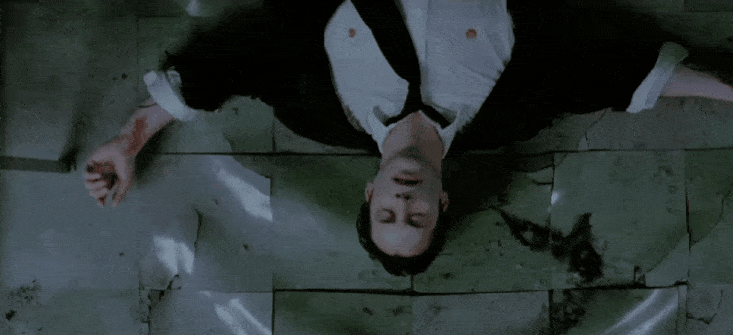
But when you start having visions of him sitting in a pool of blood and glass, dying, you have to go to him. You know he’ll be mad–but you always had a knack for talking him down--or fighting him, if you have to. He needs your help, whether he likes it or not…
TBC?
#constantine 2005#john constantine#john constantine x reader#john constantine x you#constantine x reader#constantine x you#keanu reeves#keanu reeves x reader#im not crying youre crying 😭#im sooooorrrry i couldn't get it out of my heaaad!!!
89 notes
·
View notes
Text

Maa Kali - Lotus Seat Talon Abraxas “Om Krim Kalikaye Namaha” The Transformational Energy of Maa Kali
Kali gives us many life-long lessons, but often as a storm, in a short space of time, as it as series of events on a movie-screen – such as life actually merely is! She is Agni (fire) personified as the nila-antarajihva (blue inner-flame) of fire, representing both the element of akasha (ether) in its highest state and also as Ratri Devi (the goddess as night). Her form as Shweta Kali (“white Kali”) is the goddess Ushas (Dawn) of the Vedas as Kundalini-shakti and Nirvana-shakti.
Kali is she who creates storms in our lives – but through such storms, we can see the nourishment and growth that we require spiritually. Only through tough life lessons of karma, and letting our prarabdha flow naturally and allowing Kali, the power of Saturn to unfold it, can we learn to sit back and merely witness it. We cannot force the flow, and we should not try and clutter our lives with more material associations and causes.
Today we see many so-called social-causes around the world that people become engrossed in for more material rather than spiritual gain. People get ‘married’ to Nationalist ideals and also other temporal fixations. People get caught up easily in the social sphere.
The best cause however as Kali teaches us, is to go within and contemplate the Self. All of these ’causes’ of the world were there in our past lives and will be there when we gain new bodies. They keep us entangled as people get too caught up emotionally in them. Go beyond emotions and realise the Atman or the Self. Then start your causes with a detached attitude!
This is the true meaning of Maya or Illusory energy – that creation itself is but a reflection of the Self and shall always be temporal and impermanent, as it is changing all the time, as also through the Yugasor world-ages.
As an example, just days before Guru Poornima in 2013, the day on which the Guru is honoured, here in NZ, we saw our Capital City, the seat of the Govt. rattled by a large quake. Hindu tradition tells us not to disrespect or disregard Gurus, as one of the greater crimes. Western nations do this all the time, as does the world today. It is therefore not surprising to see these occurrences in strong Shani or Saturn periods, who unleashes collective karma also, through his Shakti or power, the Goddess Kali.
Rather than being sorrowful and pitying ourselves in disasters in our lives and dwelling on them, we need to throw out this largely Semitic-based philosophy and replace it with one of Self-responsibility due to our own karmas, individually and collectively, such as Kali shows with her stern gaze.
We have a culture of taking for granted what we learn from Gurus, Acharyas or Teachers of all kinds and also elders such as parents. In the West, we throw them in rest homes when they get older, and families squabble over their possible future inheritance.
The best remedy is to start living a more sattvic or pure lifestyle in harmony with Nature, and also helping others to do so also, as we can do in Yoga and in sciences such as Ayurveda, the spiritual medical system of India, which teaches us to how to live in harmony with nature and the seasons, climates, transition of ages and so on. It teaches us how to embrace Kali’s Shakti or energy, rather than go on a material rampage to fight against it – as we cannot win!
We need to live with The Mother Divine, not against her, or she, as a good Mother does, will always chastise us!
Humans need to learn to let go of their egos that they are the only beings on this planet and start to respect fellow-beings, as also Mother Nature herself. Kali teaches us that if we are Raktabija, the demon of desire, then we shall simply generate more and more desires that further karmically entangle us. Her ways are often sudden and extreme live the downward path of a rollercoaster at Disneyworld, however she, as a faithful mothers, removes those desires from us once and for all through cold, hard truths and confrontation with our own past.
Kali is most merciful, but also the great teacher who bursts our egos if we get too engrossed in the Aham-kara (I-ness) as opposed to the true Aham (I-AM), that of the Self or Atman! The lesson here is to go within!
27 notes
·
View notes
Text
Katara the selfcare queen
Every canon instance or mention (that i can rmr) of Katara indulging in selfcare in the middle of a war because I find it quite amusing yet fascinating.
I may or may not have made a post like this before but I wanted to expand on it.
1. Skincare routine

In 1x14, The Fortuneteller, Katara reveals she has a special seaweed lotion that she carries with her for soft skin. (Avatar Extras also made a point of saying that it smells…?) She even offers to get Aunt Wu some, as if she has extra. So my question is, who is this plug that she gets her steady supply of seaweed lotion from? 😭
Real-life: Seaweed has been used in skincare for thousands of years, first recorded in ancient Chile. Nowadays, seaweed extract is pretty common in skincare products especially from emerging brands in Nunavik and Iqaluit, Canada.
My headcanon: This is probably a recipe Katara picked up from the older women of her tribe, so she just plucks some seaweed whenever the gaang stops by a body of water. And she definitely makes it in cute glass jars and shares it with her fellow healers in the Republic City Hospital ✨selfcare queen✨
2. Spa Day
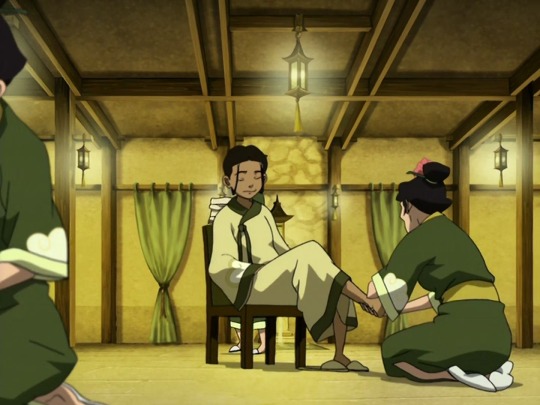
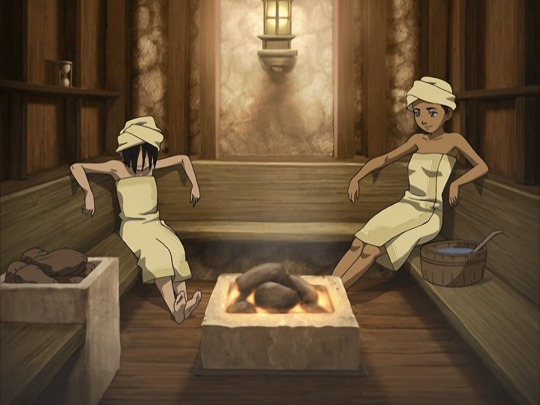

I just find this funny because when and how did she even find this spa? How long has she been going by herself? Look how comfortable she is like dhjfjcd she’s definitely a regular and they all know her.
Real-life: Saunas are pretty modern, starting up in Finland around 1112. (In canon, I think a firebender and a waterbender run a sauna in Republic City so hey.) Mudbaths on the other hand have been around for centuries and people have been doing it at any naturally occurring hot spring they can found. I don’t even have to tell you about massages so
My headcanon: Katara always knows where the spas and selfcare places are wherever they go. I definitely think she scooped up some stuff at the perfume abbey in season 1 (because she’s a kleptomaniac). I also headcanon she would have a spa setup in the back of Republic City Hospital because selfcare is healthcare too. Also, Aang gives her massages at home and he’s surprisingly good at it, but, Katara sucks at massages and Aang never lets her do it to him after that one time 💀
3. Yoga
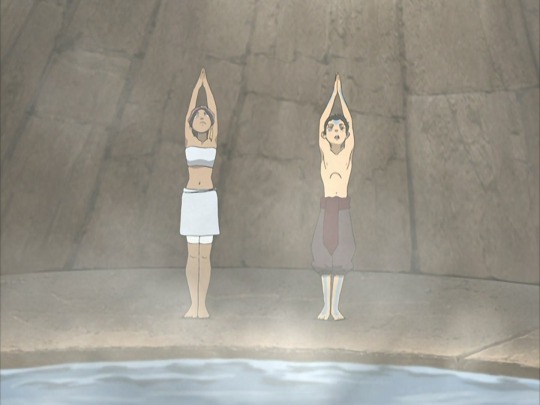

In 3x11, Nightmares & Daydreams, Katara teaches Aang yoga to de-stress in a hot spring. My thing is, when did she learn about yoga and how often does she do it? We needed the Katara yoga mini shorts special. The kids would’ve loved it.
Real life: Yoga originating from ancient India is practised in a variety of forms in Hinduism, Jainism and Buddhism. The poses they do are the Upward Salute and the Wide Legged Forward Bend.
My headcanon: I imagine Katara must have read about this at the Air Nomad Section of the Spirit Library, given the cultural heritage. Knowing her she found a yoga scroll and swiped it (can you say klepto?). This is another selfcare thing she does with Aang because it’s his culture! They do it every Saturday until he starts complaining about his old bones 😅
4. Hair care
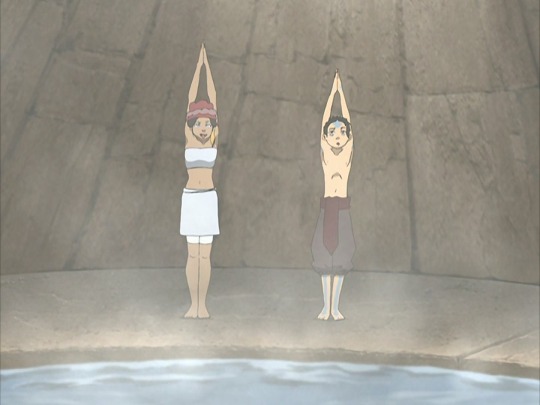



Katara also wears a special cap on her head when doing yoga which I assume is to protect her hair from the steam 🤔 I just found it very interesting since we hardly see her hair covered. Then I also realized Katara is the only character shown actually combing her hair and styling it like 4 times: from the bun-braid, to the formal earth kingdom look, to her fire nation look and finally the bun with her hair out.
Real life: I typed so many things and I finally found something similar called a chinoiserie satin skull cap? (sorry pic limit). It’s similar in design and even has a tassel like Katara’s. Focusing on her hairstyles, the signature “hair loopies” are actually based on a traditional Inuit style known as qilliqti and her earth kingdom look is based on a traditional Manchurian style called liangbatou.
My headcanon: Like Katara’s mysterious seaweed lotion recipe, she probably makes several haircare products for herself, and has a major hair routine. So, it would make sense she wears protective caps from time to time. I also think both Hama and Katara are tied to the myth of Senna, the Inuit sea goddess, through the comb Katara uses which I headcanon is the identical comb Hama had in her home (again klepto).
If there’s any more selfcare moments I left out, please feel free to share or reply with your own Katara ✨selfcare queen✨ headcanons!
#atla#katara#self care#self care queen#skincare#spa#yoga#haircare#culturalexploration#my headcanons#kataang#anti zutara
240 notes
·
View notes
Note
WIBTA if i (19) told my mom (54) not to travel to learn to become a yoga instructor?
my family is fairly wealthy. not crazy levels, but my parents own their home, lease a small cabin, and we go on a family vacation (as in plane tickets) once a year. my mom is one of the top employment lawyers in our area and my dad is a public school teacher. she was the first person in her family to go to university.
both my parents have been doing yoga on and off for at least a decade at this point, and my mom decided she wants to do training to become a yoga instructor on top of practicing law. i thought, that's great! something to help her manage her stress and keep her motivated to exercise!
turns out, she wants to travel and do a four week program in india, bali, or thailand. we live in canada. my mother is white and british. i don't think this is a great look. when she first told me, i said something along the lines of "oh... how colonial of you" but i think she thought i was kidding.
i've been considering telling her that i don't really approve of this and asking her to instead donate the money she would have spent on the journey to a palestine relief fund or something, and do the training locally.
this is where the real potential assholery comes in: in january to may this year, i spent about 9000 dollars on a mental-breakdown-inspired trip to france, which i paid for myself after working full-time in a warehouse for several months. i might be an asshole, and i might be a hypocrite. i don't know.
What are these acronyms?
127 notes
·
View notes